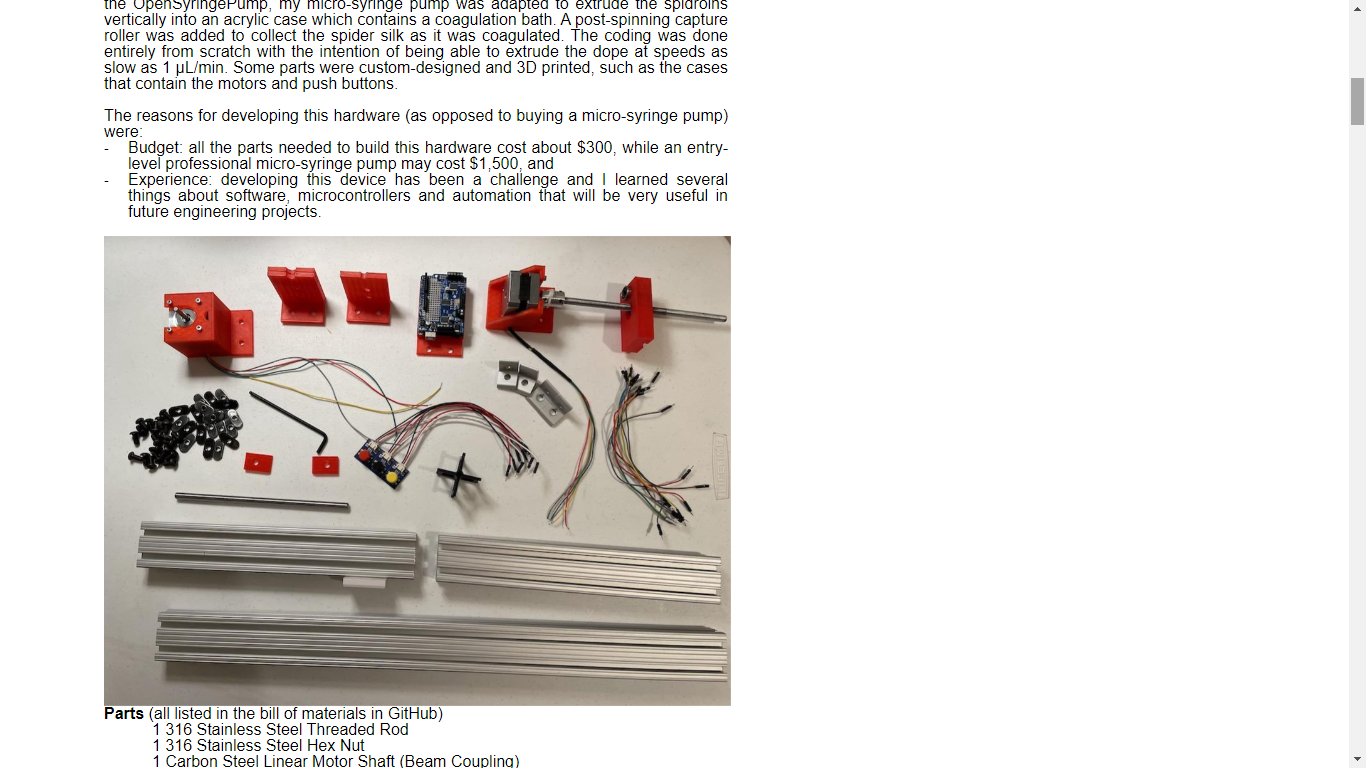There are many techniques to spin spider silk, the easiest of which is wet spinning, in which the spidroins are dissolved in a chemical solution (for example, saturated ammonium, hexafluoroisopropanol in methanol, hexafluoroacetone hydrate in methanol, and formic acid in methanol) before entering a coagulation bath that removes the solvent and causes conformational changes [1, 2]. To do wet spinning, we need a microsyringe pump capable of extruding the dope at a flowrate as slow as 1 μL/min into a coagulation bath. Once the spidroins have coagulated, a post-spinning roller will collect the spider silk. Because of the microsyringe pump’s design, shear force will help in the coagulation process of the spidroins [1, 2, 3]. Moreover, once the spidroins and gold nanoparticles are in the syringe the oxygen will be purged with Nitrogen gas to increase the chances of binding the gold nanoparticles and spidroins together.
Figure. A) Microsyringe Pump based on a micro-controller-enabled stepper motor that pushes the syringe at the desired flowrate; B) Coagulation bath where the spidroins will be pushed into. This will be filled with a chemical such as isopropanol; and C) Post-spinning roller that will collect spider silk after it has coagulated.
References
-
Rising, A., Johansson, J. Toward spinning artificial spider silk. Nat Chem Biol 11, 309–315 (2015). https://doi.org/10.1038/nchembio.1789.
-
Madurga, R., Gañán-Calvo, A. M., Plaza, G. R., Guinea, G. V., Elices, M., & Pérez-Rigueiro, J. (2017). Production of High-Performance Bioinspired Silk Fibers by Straining Flow Spinning. Biomacromolecules, 18(4), 1127-1133. https://doi.org/10.1021/acs.biomac.6b01757.
-
Andersson, M., Jia, Q., Abella, A., Lee, X.-Y., Landreh, M., Purhonen, P., Hebert, H., Tenje, M., Robinson, C. V., Meng, Q., Plaza, G. R., Johansson, J., & Rising, A. (2017). Biomimetic spinning of artificial spider silk from a chimeric minispidroin. Nature Chemical Biology, 13(3), 262-264. https://doi.org/10.1038/nchembio.2269.
Welcome to the ©BÆ₽Чok_HO₽TKAHb Allianz wiki!
A few ARTI©LE$:
Abstract Spider silk is strong and extensible but still biodegradable and well tolerated when implanted, making it the ultimate biomaterial. Shortcomings that arise in replicating spider silk are due to the use of recombinant spider silk proteins (spidroins) that lack native domains, the use of denaturing conditions under purification and spinning and the fact that the understanding of how spiders control silk formation is incomplete. Recent progress has unraveled the molecular mechanisms of the spidroin N- and C-terminal nonrepetitive domains (NTs and CTs) and revealed the pH and ion gradients in spiders' silk glands, clarifying how spidroin solubility is maintained and how silk is formed in a fraction of a second. Protons and CO2, generated by carbonic anhydrase, affect the stability and structures of the NT and CT in different ways. These insights should allow the design of conditions and devices for the spinning of recombinant spidroins into native-like silk. **Шелк паука **прочен и растяжим, но при этом биоразлагаем и хорошо переносится при имплантации, что делает его идеальным биоматериалом. Недостатки, возникающие при репликации шелка пауков, связаны с использованием рекомбинантных белков шелка пауков (спидроинов), в которых отсутствуют нативные домены, использованием денатурирующих условий при очистке и прядении и тем фактом, что понимание того, как пауки контролируют образование шелка, является неполным. Недавний прогресс раскрыл молекулярные механизмы N- и C-концевых неповторяющихся доменов спидроина (NTs и CTs) и выявил градиенты pH и ионов в шелковых железах пауков, прояснив, как поддерживается растворимость спидроина и как образуется шелк во фракции. секунды. Протоны и СО 2, генерируемые карбоангидразой, по-разному влияют на стабильность и структуру NT и CT. Эти идеи должны позволить разработать условия и устройства для превращения рекомбинантных спидроинов в нативный шелк.
artificial-spider-web-gets-an-ionic-boost
The New Yorker: в будущем мы все будем носить паучью паутину
Шелковые текстильные волокна и ткани: Строение и основные свойства фиброина шелка.
белок шерсти кератин содержит аминокислоту цистин (цистеин), которая обеспечивает особые свойства шерсти. Белок шёлка фиброин содержит аминокислоты глицин и аланин, что обеспечивает его гладкость, блеск. Хлопок имеет такой же состав, что и вискоза: это целлюлоза - основа любой растительной клетки (С6Н10О5)n, Лавсан - синтетическое полиэфирное волокно получается на основе этиленгликоля и терефталевой кислоты, поэтому его элементарное звено имеет состав: (-О-СР2-СН2-О-СО-С6Н4-СО-)n
project parts:
https://github.com/barionleg/Spider-Web-Simulation
https://github.com/barionleg/Biosteel_UTMOST
https://aibolem.github.io/svaerchok_nortkan/docs/main.html
https://github.com/aibolem/svaerchok_nortkan
https://github.com/aibolem/spider-silk-hardware
https://github.com/barionleg/bionetsim
https://github.com/barionleg/OpenSyringePump
https://aibolem.github.io/spider-silk-hardware/html/esilkprojectthesis.html
https://aibolem.github.io/spider-silk-hardware/html/esilkproject_ru.html
https://aibolem.github.io/spider-silk-hardware/html/SyringePumpGuide.html
https://aibolem.github.io/spider-silk-hardware/html/syringepumpassemblyguide.html






